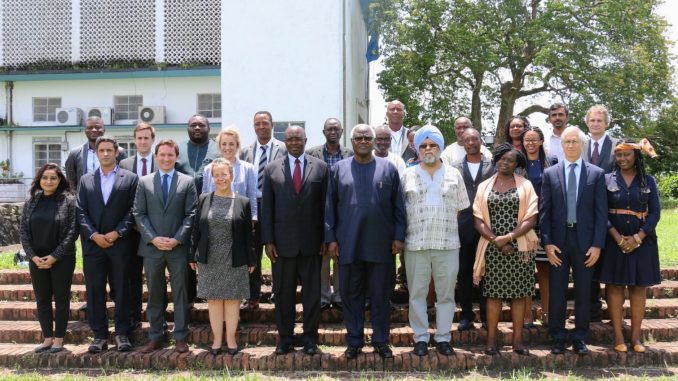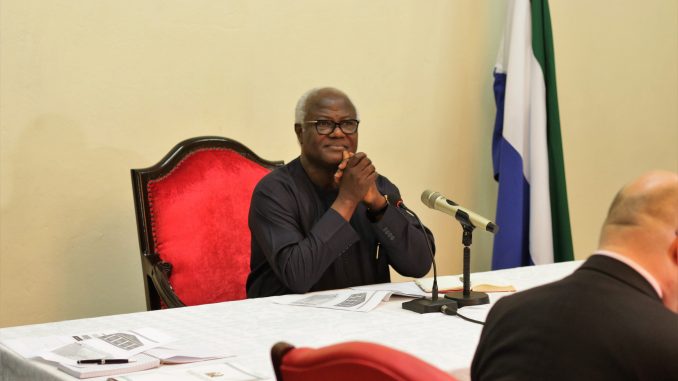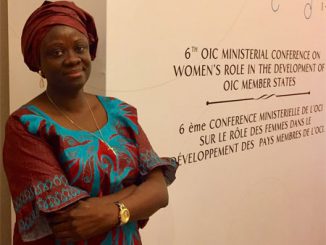
By Moses A. Kargbo
Preliminary findings of a rapid disaster assessment were presented on Friday to President Ernest Bai Koroma at State House in Freetown. The assessment quantifies the damage and loss and recovery needs associated with the August 14 landslide and flooding in the Western Area. The presentation was also attended by government ministers and officials, Ambassadors and heads of UN agencies.
The rapid assessment was developed in partnership between the Office of National Security (ONS) and national and local government agencies, World Bank, UN agencies, with the support of the EU and other international and bilateral organizations.
The rapid disaster assessment highlights the economic and human impacts of the disaster. The report will focus on estimating the economic costs of the disaster. It is recognized that the massive loss of human life, and the suffering of those who have lost loved ones, cannot be monetized. Further detailed analysis may be needed to consider the broader socio-economic impacts of the incident, and associated needs.
President Koroma listens with rapt attention to the presentation of the report
Preliminary recovery needs are identified in the report, across sectors in the short (0 to 3 months)-, medium (4 to 12 months)- and long-term (1 to 3 years). It is hoped that this report will be used by the government to inform the design and implementation of a comprehensive resilient recovery plan and recovery financing strategy.
To accomplish the objectives of the assessment in a rapid manner, the World Bank team used new technology and tools such as drones and satellite imagery. The drone survey mapping, with ground control from Edward Davies Associates (EDA), covered the 7km corridor of the main landslide event on August 14 (Regent – Lumley). The value added of using the high-resolution imagery (8cm) and 3D ground model was the detailed remote visual inspection of slip, debris and damage, and creation of 3D models for design of stabilisation and rehabilitation works. This also helped in creating useful datasets for other agencies working on recovery.
The hazard assessment was managed by a team of English geologists and engineers from Arup and the British Geological Survey who were involved in the Multi-City hazard and risk assessment, an on-going Office of National Security (ONS)-World Bank study in Freetown, Bo and Makeni.
The team also collaborated with INTEGEMS, a local geo-information and environmental consultancy from Freetown, who managed field damage assessment surveys and recorded the data on GPS-enabled smartphones with GIS software. The 12 volunteers from INTEGEMS downloaded their data daily to give immediate geo-referenced information about damage and losses. This allowed the World Bank team to evaluate building typologies and damages, personal asset losses, effect on livelihoods, etc. INTEGEMS’s volunteers managed to complete more than 500 household surveys in 3 days often in suboptimal weather conditions.
World Bank Country Director for Sierra Leone, Henry Kerali, said the assessment helped determine the human impact of the disaster. He said the full report will be presented to the President at the end of September, and that “the Bank stands ready to continue supporting the Government and people of Sierra Leone to quickly recover from this disaster”.
“The team has done a great job on what the immediate priorities are, and we look forward to guidance from the Government on the areas that need immediate support on, and how to proceed,” said Parminder Brar, World Bank Country Manager for Sierra Leone at the end of the presentation at the State House. “We’ll continue to work with other development partners to ensure Sierra Leone quickly recovers from this disaster.”
Between 1st July and 14th August, 1,040 mm of rain fell on Sierra Leone, which is three times more than the average over this period. The loss of forest and spread of urbanisation brought more challenges for sustainability of the environment; while 60% of forest in the northern flank of Freetown has been lost in the last four decades. These, according to the report, were contributing factors to the landslide and flooding disasters.
Reacting to the presentation of the preliminary report, President Koroma said he was impressed by “the quick and highly professional response” of the Bank to Government’s call for assistance. He lauded the quality of the output that came from the team’s assessment and looked forward to receiving the final report, which will present the findings in detail and is expected to guide the recovery effort as well as inform future land use planning regulations and their enforcement, and strengthening of disaster risk management capabilities in the country.
“The disaster was well beyond the capability of the Government, but thankfully, the World Bank was already on the ground doing similar assessment when the disaster struck,” he said. “The call was responded to quickly because of the need and urgency. For us, the response from the Bank was quick, and the support provided by all the agencies is being appreciated. It is now our responsibility as a Government to look at this report quickly and engage with other partners to agree on the way forward.”
President Koroma noted that he was happy Sierra Leoneans were part of the assessment and thanked the team “for putting out such a quality work in such a limited time”. “We’ll stay engaged until the recommendations in the report are fully addressed,” he concluded.
The physical damage done by the disaster is estimated at more than US$30 million (about Le230 billion). Destruction was done to health, education, transport, and housing facilities, among others. US$82 million is needed to support the recovery effort.
The social sector represents more than 80% of the total damage and loss: Housing – 55%; Health – 11%; Social Protection – 10%; other affected were Water and Sanitation – 8%; Industry and Commerce – 3%; Environment and Debris Management – 6%; Education – 3%; Transport – 3%.
On the short-term (0 – 3 months), US$15.1 million is estimated for urgent relief. For the medium-term (3 – 12 months), US$24.7 million is needed for early recovery, while for the long-term (1 – 3 years), US$42.2 million is projected for resilient recovery; making a total of US$82 million.
Meanwhile, President Koroma promised that his Government will look at the report and quickly respond to the recommendations made therein.
A cross section of the DaLA team and World Bank staff pose for a group photo with President Koroma after the presentation




